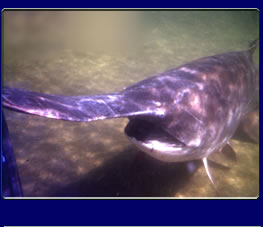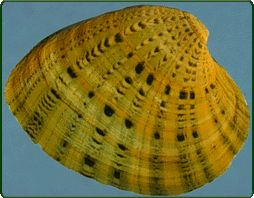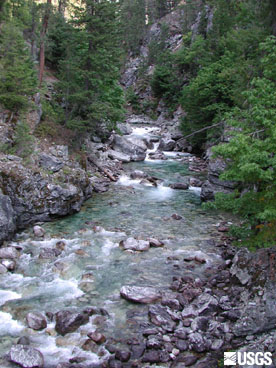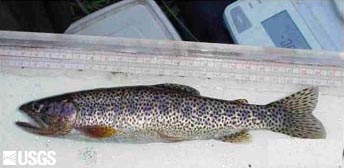- Home
- About S&T
- Taxa/Organisms
- Ecosystems
- Issues
- Methods & Tools
- Reports & Publications
- Location
- Search
 Status & Trends Home
Status & Trends Home  Ecosystems
Ecosystems  Inland Waters
Inland Waters  Rivers and Streams+Threatened and Endangered Species
Rivers and Streams+Threatened and Endangered Species
Publisher: USGS | Science Center: Western Fisheries Research Center (WFRC, Seattle) | Format: URL
wfrc.usgs.gov — Little is known about the importance of estuarine habitats for juvenile chinook salmon (Oncorhynchus tshawytscha), hence managers are uncertain of the appropriate levels of protection for such habitats. Research to determine the length of residence and growth of juvenile chinook salmon in the Skagit River estuary will indicate the importance of More...

Publisher: USGS | Science Center: Western Fisheries Research Center (WFRC, Seattle) | Format: URL
wfrc.usgs.gov — Fall chinook salmon (Oncorhynchus tshawytscha) in the Snake River are currently listed as threatened under the Endangered Species Act (ESA). Although fish bypass systems reduce the mortality of fish entering turbine intakes at mainstem hydroelectric dams, they are only operated during the spring, summer, and early fall during the peaks of seaward More...

Publisher: USGS | Science Center: Upper Midwest Environmental Sciences Center (UMESC, LaCrosse) | Format: URL
www.umesc.usgs.gov — Paddlefish (Polyodon spathula) have been lost from four states and Canada, and 11 of 22 states within the remaining species range now list the paddlefish as endangered, threatened, or a species of special concern. Restoration of paddlefish populations is a shared goal of many state and federal agencies. UMESC scientists, in collaboration with the More...

Publisher: USGS | Science Center: Columbia Environmental Research Center (CERC, Columbia) | Format: URL
www.cerc.usgs.gov — The BFRS works cooperatively with team members from CERC and with faculty and graduate students of Department of Wildlife and Fisheries Sciences at Texas A&M University in research areas represented by the branch structure of the CERC including toxicology, ecology, biochemistry and physiology, environmental chemistry, ecogeography, and information More...

Publisher: USGS | Science Center: Western Fisheries Research Center (WFRC, Seattle) | Format: URL
wfrc.usgs.gov — Threatened and endangered salmonids in the Pacific Northwest often use backwaters and wetlands as they migrate toward the ocean, however our understanding of the role of wetlands to juvenile salmonids is limited. The major Objective of this study was to determine whether juvenile steelhead were being tapped on the wetland during spring, and More...

Publisher: USGS | Science Center: Western Fisheries Research Center (WFRC, Seattle) | Format: URL
wfrc.usgs.gov — Fall chinook salmon (Oncorhynchus tshawytscha) in the Snake River are currently listed as threatened under the Endangered Species Act (ESA). Because fall chinook salmon migrate seaward during the summer when flows are low and water temperatures are high, their survival rate is lower. The goal of this study is to more clearly identify the More...

Publisher: USGS | Science Center: Western Fisheries Research Center (WFRC, Seattle) | Format: URL
wfrc.usgs.gov — Bull trout were listed by the U.S. Fish and Wildlife Service as a threatened species throughout the Columbia and Klamath river basins in 1998, and Oregon has listed the North Fork Malheur River population "Of Special Concern". Reasons for the decline of bull trout in the Malheur River likely include habitat degradation, habitat fragmentation, and More...

Publisher: USGS | Science Center: Western Fisheries Research Center (WFRC, Seattle) | Format: URL
wfrc.usgs.gov — Bull trout in the western United States are now listed as threatened under the Endangered Species Act. One cause of bull trout population declines is fish passage issues caused by dams and diversion structures. In order to best design or modify culverts and other fish passage structures in watersheds where bull trout are present, baseline swimming More...

Publisher: USGS | Science Center: Upper Midwest Environmental Sciences Center (UMESC, LaCrosse) | Format: URL
www.umesc.usgs.gov — Freshwater mussels are the largest group of federally listed endangered or threatened invertebrates, and their declines may signal declining riverine health. They are a renewable resource, providing significant ecological and economic benefits to the Nation. Our study uses a landscape-level approach to assess whether the distribution of mussels More...

Publisher: USGS | Science Center: Western Fisheries Research Center (WFRC, Seattle) | Format: URL
wfrc.usgs.gov — As salmonid populations continue to decline in the western US, it is imperative to develop a better understanding of ecological, genetic, and biological aspects of these species. Within the broad context of the Fisheries and Aquatic Resources Program the 5-year research goals address: development of non-lethal genetic procedures for identification More...

Publisher: USGS | Science Center: Western Fisheries Research Center (WFRC, Seattle) | Format: URL
wfrc.usgs.gov — The goal of this project is to provide vital information on the current status of cutthroat trout (Oncorhynchus clarkii) populations as a necessary prerequisite to determining need and type of future recovery efforts. Coastal cutthroat trout were petitioned for listing under the Endangered Species Act in 1997.

Publisher: USGS | Science Center: Western Fisheries Research Center (WFRC, Seattle) | Format: URL
wfrc.usgs.gov — The Santa Ana sucker (Catostomus santaanae), was recently identified by the U.S. Fish and Wildlife Service (FWS) as a species of special concern. This sucker is endemic to the Los Angeles, San Gabriel, and Santa Ana river drainages of southern California. The purpose of this study was to develop a better understanding of environmental factors More...
